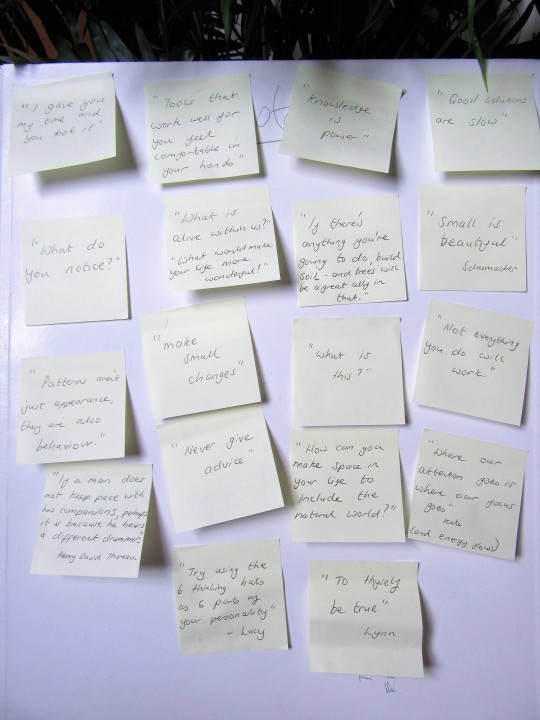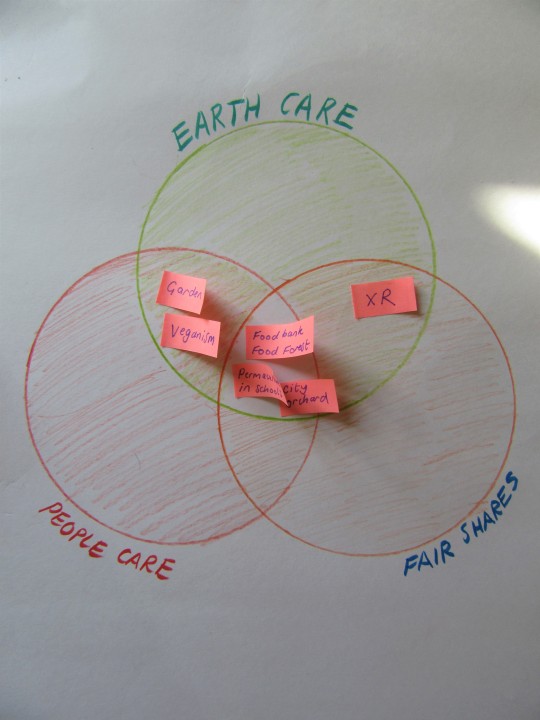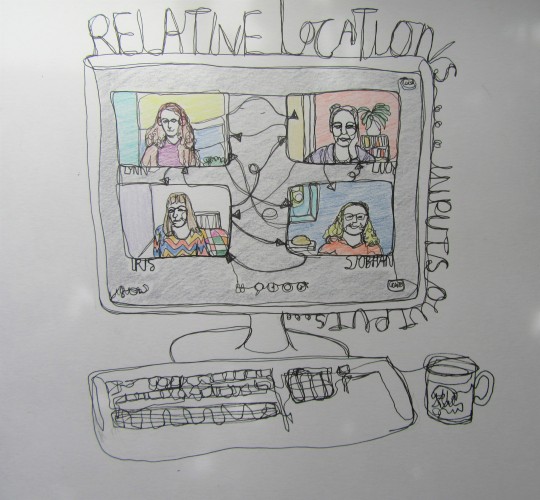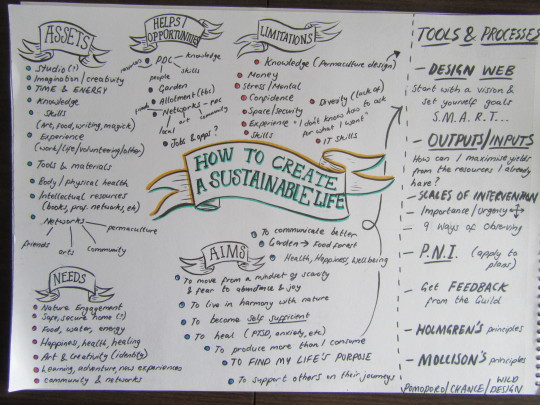#futreproof
Text
Permaculture Design Course
We dialled in from living rooms, bedrooms, caravans and gardens across 11 different time zones, from Abu Dhabi to California (with Brazil and Berlin somewhere in between). Our reasons for being here were all unique and yet all similar; concerns for the future; for the mass extinction event and loss of natural habitats; hoping to learn how to live sustainably; how to grow food naturally; how to produce more than we consume; how to change career; how to live without doing harm; and how to co-create a better world for our children and future generations to grow up in. In the context of one of the biggest worldwide pandemics in living history, this group of strangers met in the timeless hinterland of the online meeting room to explore, share, and learn about positive solutions both now and for our futures...
I stumbled across The Permaculture Design Course quite by accident (as I was looking for ways to make my struggling garden thrive rather than merely survive) but, over the course of a month, this unexpected experience changed my life completely... For the first time in 35 years I feel that I have been given access to a toolkit for living - a set of frameworks, processes and principles which speak entirely to what I feel and know to be real and right - for how to be and live in the world in deeply connected, holistic and sustainable ways... At a moment when I was feeling incredibly helpless and overwhelmed by global and personal circumstances, the PDC and this group of wonderful, disparate strangers, appeared “as if by magic” and turned around the whole way I understand myself, my power, and my place in the world. On my ‘rewriting trauma’ journey the PDC has been an invaluable turning point and has provided me with the maps and materials I most need (though may not have been looking for) for going forwards...
Since finishing the course I have been asked numerous times by friends, family and neighbours “What IS Permaculture, exactly...?” And I have responded with numerous answers (according to who was asking, their reasons for asking and the context in which the question was asked) but I would like to take this opportunity to address that question, in the best way I know how, through the precious and manifold ideas and conversations which came up throughout the course. I want to respond to the question “What is Permaculture?” in this way (rather than offer a singular narrative) because I believe this embodies and reflects much more of the essence of what Permaculture is : a set of principles, processes and frameworks for living which can be tailored to the particular and specific answers and solutions each one of us seeks in our own, unique context.

Word bubble formed from the PDC reactions to the question “How do you define Permaculture?” 2nd June 2020
“You can’t have sustainable food production without sustainable everything else.”
Graham Bell, Online PDC, June 2020
June 2020 was an astonishing and deeply challenging month in so many ways… Personally, I was forced to face the vulnerability of my own situation; my reliance on shop bought food and uncertain income streams when, at the very outset of lockdown, literally all of my work dried up, my partner was made redundant and access to food was scarce and difficult. Then there was worse to come. In the late hours of the 16th of June, my cousin Beth died. The news arrived during one of our PDC sessions. She had been battling secondary and primary breast cancer. This is a heartbreak and a loss I am still trying to understand and process (but one which, had I not been held by this group and this experience, would have been so much harder to deal with).
Meanwhile, on the international stage, people were facing so many additional threats and challenges posed by the Coronavirus Pandemic. The death statistics highlighted the social and economic inequalities, both at home and abroad, particularly along lines of race - with a disproportionate number of deaths and redundancies in people from BBIPOC (Black, Brown, Indigenous, People of Colour) backgrounds. We saw deaths in refugee camps sky rocketing. These statistics were a bitter salt in the wounds of exhaustive and institutional racism which we saw enacted again and again from the refugee crisis in Syria and Yemen to the police murders of George Floyd in Texas, Israel Berry in Oregon, Tracy Downe in Florida and many more besides… Some of us white folx, in waking up to the scale and pervasiveness of institutional and embedded violence towards our African, Asian and South East Asian Diaspora friends, that we (I) started to understand our (my) own white fragility and the systems of dis/advantage which many of us have been complicit in. And it was amidst this context of great uncertainty and upheaval that the PDC took place...
Over the course of the month of June, with three day-long zoom meetings a week and a handful of break out/additional sessions in between, we explored (amongst many things); the ideas and inspirations behind Permaculture; the centrality of Observation; Non Violent Communication; Patterns; Input & Output Analysis; Wild Design; Trees and Soil; Guilds - what they are, how they work, making our own; Arts and Culture(s); Landscape; Climate; Planning for the future; Alternative Exchange Economies; Food and Water; Six Coloured Thinking Hats; Plant Families and Nomenclature; Sociocracy; Healing; Cooperation vs Competition; Zones and Sectors; Needs, Wants and Offers… And many more things besides and between.
Though I was not aware of it at the time (though I might have been, had I read the curriculum and course handbook in advance!) almost the entire first half of the PDC was taken up with the co-creation of a safe and productive learning space and culture.
One of the first questions posed to the participants was from Kate Everett who asked “What makes learning work for you?”
I struggled to identify what had worked for me in the past but could instantly conjure what made learning not work: I thought of GCSE revision, 20 cups of tea a day, desperately cramming information into my head… I thought back to how long it had taken me to learn how to tie shoe laces or to put up a tent because of how much heat and anger there was from my father and his father that I couldn’t just do it… I thought of those feelings of shame, humiliation, stress and of shutting down when I was told I was an idiot and a failure… But then, interestingly, so many others in the group articulated similar experiences - “stress, school, competition”…Some people described themselves as lone wolves, others learnt better in groups, some benefited from working together over a problem or by sharing what they were learning… But what all of us agreed upon was the inhibiting effects of stress on learning and the need to enfold experimentation, play, overview and failure in order to make our learning journeys productive and engaging...
“Learning is love”
Graham Bell
Little did we know it at the time but all this information about our individual learning experiences was being observed, gathered and harvested… as we learnt about ourselves and one another we were also learning how to create the best learning (and hence growing) conditions for us as individuals and as a collective. Though we may not have fully realised it as it was happening, we are all in the “inverted classroom” : we had all become the teachers, as well as the students and would learn more from the collective than any single teacher or pedagogy could ever bestow...

Quotes and prompts I collected throughout the course
“A person who doesn’t make a mistake probably doesn’t make anything”
Graham Bell
Mark Shiperlee introduced us to the concept of the Culture Board and we begin brain storming what factors are important to measure our course culture against. The factors we decided were of most importance to integrate into, and develop throughout, the course were;
Positive Solutions
Long & Short Breaks
Gift Economy
Time Keeping
Mutual Respect
Fun
Creativity
Task Setting & Reporting
Inclusion
Group Work
Connect With Nature
Throughout the course we would check in on the Culture Board regularly to determine what stage these various factors were at i.e. Seed; Sprout; Leaf; Flower; or Fruit. For me this was a valuable tool in understanding where the group felt our learning journey was at - which areas were working and which were not. It made this an easy, fluid and almost anonymised process and helped to address both the successes and the failures as we went along, understanding where energy needed focusing. This was one of many visual tools, along with The Life Ethics venn diagram, Six Thinking Hats, OBREDIMET, Looby’s Design Web, Input & Output Analysis, PMI (Plus, Minus, Interesting) Analysis, Importance/Urgency Matrix, and Relative Location which I have continued to use in my own Permaculture Life/Design Processes…

My LIfe Ethics Venn Diagram - i.e. the three main ethics of permaculture”Earth Care”, “People Care” and “Fair Shares” Where they all intersect is the core of Life Ethics
During the course we were also given our own break out Guild groups with whom we had to develop ad present a Permaculture Design Project with (below is ‘an artist’s impression’ of our Guild The Four Acorns - Lynn, Siobhan, Lucy and myself.

“Though the problems of the world are increasingly complex, the solutions remain embarrassingly simple”
Bill Mollison
By the third week of the course, with each one of our guild feeling exhausted by various life stresses (illness, work, family, bereavement, etc) we decided the best and most effective design we could work on was one for supporting each other as a guild whilst we embarked upon our permaculture journeys (the one thing which united all of us was that we wished to continue beyond the course).
We started applying some of the tools and processes we acquired throughout the course to our own visions for the future. We started off with Holmgren’s Permaculture Design Principles;
Principle 1. Observe & Interact
We began our guild process by gradually getting to know one another, developing & discussing project ideas that would tap into all of our needs & aspirations.
Principle 2.Catch & Store Energy
As we were all feeling a bit burnout we realised we needed to do something that would hold space and energy for us as individuals and a collective i.e. catch and store energy by making and holding space for one another. We wanted to encourage each other to feel safe enough to start exploring with new eyes and to assist each other’s courage in the face of major life changes.
Principle 3.Obtain a yield
We all wanted to carry on our development beyond the course and to share permaculture with others - so we asked the questions “How could we support one another in this?” But, in addition “What renewable resources and services did we have that we could use, share and apply?” and “What could we create - the main yield - within this guild?” We decided that the yield we could create in the present, but carrying into the future, was a space full of loving-support, inspiration, challenge and abundance.
Principle 4. Apply Self-regulation & accept feedback & Principle 5. Use & Value Renewable Resources and Services
As we began using permaculture tools to explore our individual designs, these processes enabled us to support and affirm one another; to share wisdom; tell stories; hear, value and integrate one another as individuals in a guild; become energised and strengthened by our diverse experiences, perspectives, knowledge(s), points of view; and to be challenged and strengthened by processes and making compassionate space for learning through failure too... And believe me, we did fail...

Mind Map at the outset of my own Permaculture Life Design exploring my assets, helps/opportunities, limitations, needs, aims and potential tools & processes to employ
“It takes shit... literal shit... but then you get humus”
Siobhan
On the last day of the course all of the individual guilds presented their design projects and it was amazing to see the wealth, depth and diversity of those ideas and the tools and processes (which we had been given throughout the course) put into action. There were design solutions that addressed; food scarcity; social isolation; mental health issues; segregation; alienation; loss of habitat and species; water shortages; poor health; access to education; job losses; seed sharing; community spaces; and so many more big issues. It was staggering.
In such a short space of time this small group of strangers had come together and, with the support of our guides and course leaders, co-created a network of support from across the world, positively enriching one another and the larger ecosystems each of us are a part of. It was a little island of paradise which cultivated an abundance of new perspectives, hope and courage. By showing us what might be possible and - rather than getting too mired in the negative/things we cannot control - looking to appreciate what we have, what we can be and what we can create together, the PDC taught us how diversity and collaboration can help us, both as individuals and a society, develop resilience in the face of the overwhelming challenges of our times.
It was an experience I will never forget and which I hope to keep alive as I go into the future (remembering to regularly use, sharpen and adapt those valuable tools)...
#permaculture#design#PDC#trauma#rewriting#collaboration#culture#diversity#solutions#growth#tools#futreproof#sustainability#food#growyourown#IrisPriest
2 notes
·
View notes